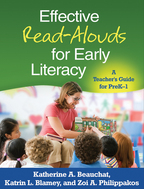Effective Read-Alouds for Early Literacy
A Teacher's Guide for PreK-1
Katherine A. Beauchat, Katrin L. Blamey, and Zoi A. Philippakos
Foreword by Sharon Walpole
A Paperback Originale-bookprint + e-book
A Paperback Original
orderApril 3, 2012
ISBN 9781462503964
Price: $33.00 140 Pages
Size: 8" x 10½"
Sharing high-quality storybooks and nonfiction books not only is enjoyable for young children and teachers—it is also a powerful way to build crucial literacy skills. This engaging guide provides effective strategies for selecting books and using read-alouds to develop children's oral language, vocabulary, concepts of print, alphabet knowledge, phonological awareness, and comprehension. Illustrated with rich examples from diverse classrooms, the book takes teachers step by step through planning and setting goals for read-alouds, as well as reflecting on each lesson to inform future instruction. Helpful planning templates can be reproduced for repeated use; the large-size format facilitates photocopying.
“A 'must read' for every early childhood educator! The authors’ wealth of expertise, wise advice, and love of reading shine on every page. They have skillfully crafted an invaluable resource designed to develop lifelong readers. This book is in tune with best practices and provides classroom-proven tools for planning rich, rewarding, and playful read-alouds. You will come away equipped and energized to set the stage for reading aloud in your own classroom.”
—Tammy C. Howell, MEd, English language arts teacher, Central York (Pennsylvania) School District
“In this excellent book, Beauchat et al. provide teachers of young children with an incredibly clear and cogent explanation of why and how to harness the instructional potential of read-alouds. Their discussion draws on current research to describe how high-interest read-alouds can strengthen children's alphabetic, linguistic, and comprehension skills. One feature that separates this book from others is the support it offers for teaching these crucial skills individually and in combination.”
—David Coker, EdD, School of Education, University of Delaware
“There is a consistent structure across chapters that makes the book reader friendly. Planning templates facilitate application of the strategies presented. I found the content to be current and evidence based. Teachers will walk away with a cache of high-utility instructional strategies; Head Start directors and other school leaders will find this book a great professional development resource.”
—Priscilla L. Griffith, PhD, Ruth G. Hardman Chair in Education and Director, Oklahoma Writing Project, University of Oklahoma
“In an engaging and accessible style—as if speaking directly to other teachers—the authors provide clear instructions for reading aloud to young children in order to develop their full potential as emerging readers. The focus on picture books, the detailed and realistic portraits of teachers in their classrooms, and the consistent format of each chapter make this a book I highly recommend for preservice and practicing early childhood teachers.”
—April Whatley Bedford, PhD, College of Education and Human Development, University of New Orleans
“Preschool and primary teachers who want to raise the caliber of their read-alouds need to read this book. Experienced teachers will enjoy the book as a smartly written refresher guide, and new teachers will find it an invaluable resource. Phonological awareness, the development of oral language and print awareness, vocabulary, and comprehension are discussed in clear, easy-to-digest chapters. Handy planning guides are provided, too. If you've ever thought you could get more from your read-alouds, you're right—this book shows you how.”
—Amy Walter, MA, primary teacher, The American School in London, United Kingdom
Table of Contents
1. Using Read-Alouds to Build Early Literacy and Language2. Preparing for Read-Alouds in the Classroom
3. Developing Oral Language through Read-Alouds
4. Developing Vocabulary through Read-Alouds
5. Developing Book and Print Conventions through Read-Alouds
6. Developing Alphabet Awareness through Read-Alouds
7. Developing Phonological Awareness through Read-Alouds
8. Developing Comprehension through Read-Alouds
9. Tracking Your Progress
Appendix. Blank Planning Templates
Children's Books
About the Authors
Katherine A. Beauchat, EdD, is Associate Professor at Middle Georgia State University, where she teaches graduate classes in literacy education and dyslexia. Her educational career includes teaching in Head Start, PreK, and kindergarten. She has served as a PreK–3 reading specialist, a middle school reading coach, and an Early Reading First Head Start coach. Her research interests include professional development in literacy and language instruction for early childhood educators, in the context of the science of reading, and effective strategies to bolster at-risk young children’s oral language and vocabulary development.Katrin L. Blamey, PhD, is Associate Dean of the School of Education at DeSales University in Center Valley, Pennsylvania, where she teaches courses in the Elementary Education certification program. Her research interests include implementing effective vocabulary instruction in the early childhood classroom and working with preservice and inservice teachers to provide effective literacy instruction for all students.
Zoi A. Philippakos, PhD, is Associate Professor of Reading and Elementary Education in the College of Education at the University of North Carolina at Charlotte. Her research interests include reading and writing instruction for students in the elementary grades, strategy instruction and self-regulation, and approaches to professional development for classroom teachers. A former elementary school teacher and literacy coach, Dr. Philippakos is coauthor of Differentiated Literacy Instruction in Grades 4 and 5 and
